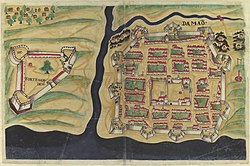Daman
| Daman | ||
|---|---|---|
|
|
||
| State : |
|
|
| Union Territory : | Dadra and Nagar Haveli and Daman and Diu | |
| District : | Daman | |
| Location : | 20 ° 25 ′ N , 72 ° 51 ′ E | |
| Height : | 5 m | |
| Residents : | 44,282 (2011) | |
| Daman's residential area | ||
Daman is the capital of the Indian Union Territory of Dadra and Nagar Haveli and Daman and Diu and the administrative seat of the district of the same name . The city was part of the Portuguese colonial empire for over 400 years . It has about 44,000 inhabitants.
location
Daman is located at the mouth of the Damanganga River in the Gulf of Khambhat , part of the Arabian Sea at an average altitude of about 5 m above sea level. d. The urban area, bounded in the north and south by two other rivers ( Kolak Riner and Kalunadi ), is completely enclosed by the Indian state of Gujarat . The megacity of Surat is about 120 km (driving distance) north; the cosmopolitan city of Mumbai is located approx. 177 km south. In the hinterland of Daman lies the city of Vapi .
population
Approx. 75% of the population are Hindus , approx. 20% are Muslims and the proportion of Christians is approx. 4.5%. The rest is divided between the Jains , Sikhs and Buddhists religious communities . As is common in northern India, the proportion of the male population is around 10% higher than the female population.
economy
The economic basis of small-town life is made up of fishing, handicrafts and retail. For several decades, inner-Indian tourism has also played a not insignificant role because of the alcohol ban in Gujarat .
history
After its discovery by the Portuguese in 1523, the place with its natural harbor was conquered in 1559, called Damão and fortified by building a fort. In the years 1581 to 1583 an attack by troop units of the Mughal Empire was repulsed. In 1614 the part north of the mouth of the Damanganga was annexed and called Damão Pequeno ; Between 1615 and 1627 the Fort São Jerônimo was built here . Daman was part of Portuguese India until 1961 . Daman still belongs to the Roman Catholic Archdiocese of Goa and Daman .
Attractions
The townscape is still characterized by buildings from the colonial era - the Fort São Jerônimo (1615), the Jesuit church Bom Jesus (1603) and the cathedral ( Se ) are to be highlighted .
Web links
- Daman, attractions - Photos and information (English)
- Daman, Church of Bom Jesus - photos + information
- Daman, churches - photos
- Daman - city map






